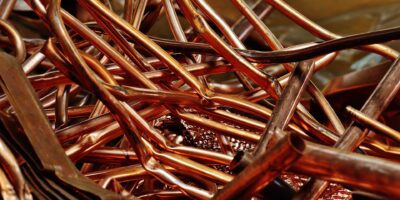15 Fascinating Facts about Volcanoes
Although volcanoes often have a connotation of destruction, volcanic activity is responsible for the formation of most of the earth’s surface, including mountains, islands, and sea floors. Most volcanoes are found around the edges of tectonic plates. Eruptions occur when the lighter molten rock rises through lines of weakness in the earth’s crust, escaping into the surface. An eruption may be explosive, or merely effusive. All this depends on the amount of pressure created inside the volcano, and the viscosity of the magma. When gases are trapped as magma escapes, pressure is built up, resulting in a violent eruption. It’s quite intriguing that so much happens underneath the ground we walk on, and the earth is indeed constantly forming. Here are some fascinating facts about these potentially dangerous yet important geological features on earth.
1. Volcanoes are named after the Roman god of fire

Vulcan by Bertel Thorvaldsen. Wikimedia Commons.
‘Vulcan’ is the name of the Roman god of fire, and a volcano in the Aeolian Islands of Italy shares an almost similar name, ‘Vulcano’. In ancient Roman mythology, Vulcan is the god of all fire, including that of volcanoes, blacksmiths’ forges, deserts, and metalworking. His symbol is usually the blacksmith’s hammer and his Greek equivalent is Hephaestus.
Here’s Everything you need to know about the Roman gods.
2. There are around 1500 active volcanoes on earth
There is no clear-cut definition of an active volcano, but most experts agree that a volcano is deemed active if it has erupted in the last 10,000 years. Most of these are found in the Ring of Fire, which is an area encircling the Pacific Ocean’s basin. These include volcanoes in Hawaii, the Cascade Range, and the Aleutian volcanic chain in Alaska. The United States has about 161 active volcanoes.
Check out the 10 Most Famous Volcanoes in the United States.
3. 75% of volcanoes are found underwater

Eruption of Kavachi submarine volcano in the Solomon Islands. Photo by Alex Deciccio. Wikimedia Commons.
Yes, the majority of the volcanoes on earth are not found on the earth’s surface. Submarine volcanoes are located underwater, along the mid-ocean ridge system. Approximately 80% of the earth’s magma output is a result of these volcanoes, most of which are located around the Pacific Ocean. Their formation is due to plate tectonic activity, such as when the oceanic plates collide, creating subduction zones which in turn allow the formation of magma.
See the Top 10 Fascinating Facts about Mud Volcanoes.
4. Volcanoes often form around the edges of tectonic plates
Tectonic plates are large pieces or slabs of the earth’s hard crust and uppermost mantle. They are majorly composed of the oceanic and continental crust. Most ssvolcanoes are found where these plates diverge or converge. As the plates collide and one slides beneath the other, a subduction zone is created. A subducted plate will sink and heat up, as water is released from the sediments in the rock. The water reduces the melting temperature of the mantle, allowing the formation of magma (molten rock), which feeds forming volcanoes at the surface. Alternatively, where the tectonic plates move away from each other instead of colliding, a new pathway is created for magma to rise and reach the surface. An example of this is Iceland, where the North American and Eurasian plates moved away from each other.
5. The formation of most of the earth’s surface is due to volcanic activity
Features such as mountains, peaks, plateaus, crater lakes, and islands are some of the landforms created by volcanic activity. For instance, when lava from an eruption flows over land for a long distance, cooling down and hardening eventually, a lava plateau is formed. The Columbia plateau is an example, and it covers over 63,000 square miles. Parts of Oregon and Idaho are made up of this. Islands may sprout where lava erupting from an underwater volcano cools to form land. The Hawaiian Islands are examples of shield volcanoes.
6. Temperatures in a volcano can rise to 1200 degree Celsius

Volcanic eruption by Enrique. Pixabay.
The molten rock inside a volcano (magma) is indeed quite hot, attaining temperatures between 1000- 1200 degree Celsius. On eruption, the molten rock (now termed lava) releases equally high temperatures and can burn up almost anything in its path. The surroundings will get very warm when a volcano erupts.
7. Volcanic eruptions can trigger earthquakes and tsunamis
Volcanic tsunamis are often attributed to violent eruptions of submarine volcanoes located underwater. Various volcanic activities such as lava avalanching into the sea, volcanic earthquakes and violent flows of lahar (volcanic mudflow) on water may trigger tsunamis. The deadliest volcanic tsunami in history was triggered by the 1883 eruption of Krakatoa in Indonesia. About 36,000 people were killed. Vibrations produced by the movement of magma and the resultant pressure may cause small earthquakes.
8. The deadliest eruption occurred in 1815

Aerial view of the caldera of Mt Tambora at the island of Sumbawa, Indonesia. Photo by Jialing Gao. Wikimedia Commons.
This was the eruption of Mt. Tambora in Indonesia. It killed about 10,000 people and created a crater 4 miles wide and more than 3600 feet deep. The eruption created grave climate abnormalities in North America and Europe. This became known as the ‘Year without a Summer’. Average temperatures dropped o.4 to 0.7 degree Celsius, and summer in Europe was the coldest between 1766-2000. As a result, there was massive famine and acute food shortage across the Northern Hemisphere, which killed a further approximately 80,000.
Read more on the 10 Volcanoes that killed most people in the World.
9. A volcanic eruption can wipe out an entire city!

The restored version of John Martin’s Destruction of Pompeii and Herculaneum. Wikimedia Commons.
Volcanoes can be deadly, from hot molten rock eruption at high speed to poisonous volcanic gases shooting so high in the sky, hot ash, and particles hazardous to living beings. Mt.Vesuvius is a massive stratovolcano in the Gulf of Naples, Italy. Its eruption in A.D 79 wiped out the Roman cities of Pompeii, Oplontis, Herculaneum, and Stabiae. With the ashes, stones, and volcanic gases shooting to a height of 33 kilometers in the sky, and molten rock flowing at an incredibly fast rate, the effects were grave. More than 10,000 people are said to have died but the number could be more. Mt. Vesuvius is still considered one of the most dangerous volcanoes, especially because about 3 million people have settled near it, making it the most heavily populated volcanic region in the world.
Read more on Top 10 Facts about the Destruction of Pompeii.
10. Volcanic gases can affect climate

Volcanic eruption emitting gases by Angel Luciano. Unsplash.
Besides the molten rock, volcanic eruptions release gases and dust particles, some of which bear a significant impact on the atmosphere. Sulfur dioxide, for instance, on reaching the stratosphere combines with water to form sulfuric acid aerosols. These form droplets which reflect incoming solar radiation, creating a cooling effect on the earth. Global temperatures may drop as it happened in the 1815 Mt. Tambora eruption. The release of greenhouse gases such as carbon dioxide, on the other hand, raises global temperatures. Effects will depend on the intensity of the volcanic activity.
11. Soils near volcanoes are quite fertile
Volcanic ash after eruption produces some of the most fertile soils, endowed with magnesium, iron, calcium, potassium, and phosphorous. Valuable mineral resources such as metal ores may also be a result of volcanic activity. Since the latter involves considerable heat flow from the earth’s mantle, geothermal power can be tapped from the same.
12. The Mauna Loa is earth’s biggest volcano

A lava flow from Mauna Loa during its 1984 eruption by R.W Decker. Wikimedia Commons.
Mauna Loa means ‘Long Mountain’. It is located in Hawaii, rising an impressive 4,169 meters. Its volume is estimated at 18,000 cubic miles. If its height beneath sea level is considered, it would be taller than Mt. Everest! It is also one of the volcanoes that formed the island of Hawaii. Located in the Ring of Fire; in the Pacific Ocean belt, it is active, but lava eruptions are usually non-explosive. Above sea level, however, it is not the tallest volcano. Right next to it, is Mauna Kea, rising 4,207 meters.
Check out the 10 Best Facts about the Hawaii Volcanoes National Park.
13. The ‘Ring of Fire holds the world’s highest number of volcanoes
The ‘Ring of Fire’ is a 25,000-mile-long zone running around the Pacific Ocean’s basin. It has about 700 of the world’s most active volcanoes, and 80% of the world’s earthquakes. Kilauea, in Hawaii, is the world’s most active volcano, and it is located in the Ring of Fire. Due to intense volcanic activity, most earthquakes occur along this region.
14. The tallest volcano in the solar system is not on earth!
Turns out some of the other planets have volcanoes too. Although Mars has no evidence of tectonic plates, it has the tallest volcano in the solar system. Olympian Mons is 27 kilometers tall and measures 550 kilometers across. It is an extinct volcano. Others on Mars include Hecates Tholus, Pavonis Mons, Arsia, and Ascraeus Mons. Planet Venus is considered a result of major volcanic activity due to its 90% basalt surface. Jupiter’s moon, Lo, has numerous volcanoes and is classified as the most volcanically active in the solar system.
Check out the 10 Most Famous Volcanoes in the World.
15. Paricutin volcano in Mexico is one of the world’s 7 natural wonders

Paricutin volcano by Karla Yannin. Wikimedia Commons.
Usually, a volcano will take years to form. Cinder cone Paricutin mysteriously appeared in a cornfield in Mexico in 1943, becoming a tourist attraction. Scientists were fascinated by this phenomenon. After 9 years of activity, it left a 420-meter cone, having damaged an area of more than 90 square miles from the ejection of lava and volcanic ash. Two surrounding towns had to be evacuated. In 1997, CNN named it one of the 7 Natural Wonders of the World. The volcano is deemed dormant now, and many visit to climb it and marvel at the phenomenon.
Planning a trip to Paris ? Get ready !
These are Amazon’s best-selling travel products that you may need for coming to Paris.
Bookstore
- The best travel book : Rick Steves – Paris 2023 – Learn more here
- Fodor’s Paris 2024 – Learn more here
Travel Gear
- Venture Pal Lightweight Backpack – Learn more here
- Samsonite Winfield 2 28″ Luggage – Learn more here
- Swig Savvy’s Stainless Steel Insulated Water Bottle – Learn more here
Check Amazon’s best-seller list for the most popular travel accessories. We sometimes read this list just to find out what new travel products people are buying.









